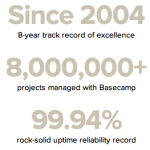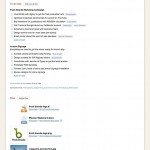
37Signals has recently launched a new version of Basecamp, their 8 year-old market-leading project management tool.
The new version is much more than a facelift: Basecamp has gone through major changes. But did it get any better?
Two weeks ago, I took part in a webinar presenting 37signals’ new version of Basecamp (codename: Basecamp Next).
This is a review post of the new version of Basecamp, after a week of playing around with it, and being a user of the original system for over 7 months.

For readers who are unfamiliar with Basecamp, it is a project management application (or service, or platform… choose your flavor).
By now, it has been already used to manage over 8,000,000 (eight million!!) projects, by companies from all around the world, including some S&P 500 companies (some more impressive statistics are available on the right of the screen).
I made a great effort last year to push Basecamp into my current workplace. It’s been a success ever since.
The greatest advantage of the original Basecamp was simplicity.
Unlike other programs and services in the field, Basecamp does not require you to be an alumnus of The Hogwarts School of Witchcraft And Wizardry in order to figure out how to use it.
For example, it only took me 30-40 minutes to train most of the personnel at my workplace and get them started.
Now that the new Basecamp is out, it’s time to see what has changed, what got better (or worse) and determine which version should you use – The New version, or the Classic one?
Before I start, I just want to make it clear: I am not an affiliate of 37signals. I get no gains from this post besides providing it as a service to my readers.
The New Basecamp: The Good
I just love the product. It made my work life better, and I think that many other people can benefit from it in similar ways.
Support
![]() The most important thing to know about 37signals, is that their support is mind-blowing. Of course, this is true for both New and Classic Basecamp versions.
The most important thing to know about 37signals, is that their support is mind-blowing. Of course, this is true for both New and Classic Basecamp versions.
The support staff are quick, kind, and helpful. They make sure that problems get solved. They care to get better and take note of the customer’s experience. They will tell you the honest truth, even if that means admitting that one of their developers has dropped the ball.
When I train support staff at my workplace, 37signals are my go-to example of how customer support should be handled. I actually sat my boss down and shown him 37signals’ support statistics, in order to persuade him that our company’s support can and should do much better.
Speed

Basecamp is now significantly faster. 37signals founders, Jason Fried and DHH claim it’s so fast, that it’s almost indistinguishable from desktop applications. So, Is it?
In one word – no.
In two words – No, BUT.
I have been testing it using a standard 2.5 ADSL connection, at my home in the Middle East. When factoring out the network latency caused by internet packets circling the globe -YES, it is VERY fast.
And the best part of it? DHH (37signals founder himself) publicly shared in great details the exact practices taken in order to achieve this improvement, educating the entire web developers community on how to get it right.
I hope that more and more developers will take notice, as Basecamp might just become the benchmark for similar applications in the near future. And I salute to DHH for taking the time to share and teach.
If you’re interested, here are the posts that DHH wrote about it:
Usability
Users of the classic Basecamp learned to live with a slightly cluttered system.
We had to-dos, to-do comments, messages, message comments, to-do lists, to-do list comments, events, event comments, and god knows what other variations.
This caused much confusion to our personnel. People just couldn’t figure it out. One always had to guess where a wanted discussion can be found. They didn’t even call it a discussion, as the phrase has only been coined in the new Basecamp!
Now, the clutter has been removed. The list of terms used in Basecamp had shrank dramatically. Complexity has vastly decreased. Focus is the new king.

The new Basecamp still has to-dos, to-do lists, events and files. But now, the same language is spoken across the board: When you post a comment on a to-do, you start a discussion. Same for to-do lists, events, files, and probably anything else that might be added later.
Now, all entities use the same terms, and all discussions are placed together and easily found on one single page – centralizing the whole project into one view (see next section – design – for more on this).
With much clearer language, Basecamp became one step simpler and easier to use. And the people rejoiced, Hooray! (to honor David Heinemeier Hansson’s native language, I’ll also add: Hurra!)
Design

I have two words for the new design. Clean. Focused.
All parts of the project are now visible on a single effective page.
No more tabs. Instead, items open and close on top of the main page – like piling up papers. Thus, you are always just one click away not only from your previous page, but also its context.
That’s it. Nothing to add.
Training
The Basecamp support staff currently offer an online guided tours to educate people on the new Basecamp and teach how to use it, including a live Q&A session. In the tour, you can get a glimpse of how Basecamp is used internally at 37signals. Interesting and fun!
I love the social proof that they are generating by requiring that all questions are posted on Twitter. Definitely a smart move. I’ll probably write a post on what the heck is social proof in the near future, if you are intrigued :).
Keeping customers In The Loop
In classic Basecamp, keeping the customer in the loop was hard. You could make his company a part of the project, but then worry about everything you or other colleagues might write or upload. Also, at least our customers, never remembered their passwords!
Now, in any discussion you want an outsider to participate, you can loop him in by filling in his email when posting a comment on a discussion. He’ll get a copy of the discussion by mail, and be able to participate in it, without giving him access to anything else. Cool. Smart. Useful.
Time tracking

The great thing about the new Basecamp’s time tracking system is: There is none.
You see, time tracking in the classic Basecamp was simply not good enough. It felt unnatural, patchy, incomplete, almost like a bastard feature born out of the Basecamp marriage.
I believe that 37signals realized it, and decided to live without this feature, rather than maintaining a feature that was not good enough for their customers.
I admire this brave decision. It’s never easy to let go of existing functionality.
According to their blog, they are currently rethinking the whole subject, perhaps for a new and better implementation, or to choose a 3rd-party tool to be integrated with the new Basecamp.
Gimmicks
The new Basecamp has tons of cool new features and gimmicks. To be honest, when I first heard some of them, I thought “Oh, come on – who needs that?”.
But, once I saw where and how it was implemented, I got it. The list of new stuff is quite long, so I will only discuss three of the features:
Gimmick No. 1: Endless scrolling
Until two weeks ago, I considered endless scrolling to be malpractice and a complete annoyance. Google paginates, and so do I!
In practice, it’s only used in the “history” page of Basecamp, which lets you scroll down smoothly and linearly through the history of all of the projects that you participate in.
Actually, it makes total sense.
Gimmick No. 2: Real time updates
Ooh, danger! I generally oppose to the idea of real-time updates, as it usually manifests into repetitive and endless interruptions. I expected the guys who wrote “Getting Real” and “Rework” to know that.
Evidently they did, which is why real-time updates in Basecamp have been implemented in a completely non intrusive manner, where:
- Updates are subtle.
- Only the stuff in current view is noticeably updated. If you’re focused on a to-do item, you’ll probably only notice real-time updates of your current item.
- There is no notification panel. I know that some people think that is a major disadvantage, but I think it’s brilliant. If you’re working on something, that item is being updated in real-time. For anything else – just check your email when you finish your task!
Gimmick No. 3: The new Calendar
Basecamp’s new calendar allows users to quickly manage events from all of their projects, in addition to unlimited number of private calendars (that they can choose to share with any user or group in the company). And you can drag and drop. I shall add no more.
The New Basecamp: The Bad
There is an old saying that “there is no good without evil”. Here is the major pitfall I encountered:
No Support for right-to-left languages
Hebrew or Arabic speaking companies that want to use Basecamp in their native language, simply cannot do so.

I really don’t get it. How hard is it to add “paragraph direction” buttons to the text editor? Even Apple, not exactly a company that cares about right-to-left language support, added this functionality to iOS and OS X years ago.
I personally don’t expect a translation or a separate right-to-left design, only the ability to align text to the right, and write it in correct direction.
Dear 37 signals, it’s as simple as adding a button generating the following code: style="direction: rtl;"
In the words of Jeremy Clarkson of Top Gear – “How hard can it be??”
The New Basecamp: The Ugly
the New Homepage
I really hope that the people at 37signals are testing conversions on their new sales page, and that I am only seeing one version of it.
I think that the sales page is horrible. Boring graphics, unreadable fonts, and generally out of focus.

To be honest, the only thing that persuaded me to even try the new Basecamp was how good the webinar was. The sales page actually repelled me from trying it out.
As a new customer, I would not understand any of the benefits in the current way in which they are presented.
Final Words
To sum up this rather long review – The new Basecamp is by far a giant leap from Classic Basecamp, and may I add – an exciting leap. I love it. It’s fresh, fast, and concise.
That said, I’d still love to know what do you think about it? How do you feel about the new features and design? How do you see its pros and cons? Please, share your thoughts.
As a bonus to my readers, first one to comment will enjoy a fantastic boost to his karma 😉
Very helpful article. I had used the original Basecamp a while back and I am now getting ready to go into another large project and didn’t know which to use.
Hi Becky,
Thanks for taking the time to leave a comment. I appreciate it, and am so happy that you found this post useful! 🙂
I think that there are only two reasons for you to go for the Classic Basecamp: Either you really need the time tracking, or you need the option to create project templates (allowing you to duplicate basic to-dos and files automatically when you start a new project).
If you require none of the two, I’m sure that the new version will carry more value for you – especially for a large project. The increased speed and extremely better organization, language and design make it much easier to use the new Basecamp compared to the classic one.
Also, don’t forget that 37signals are still providing free online classes for the new version, so your team can be efficiently taught on how to use the tool without the hassle of preparing your own training (though you might need to add some of your own methodology afterwards).
I hope that this reply, in addition to the information in the review, gives you enough information to make your decision.
Do feel free to ask more questions if they pop up!
I’d love it if you could come back and share the process, your own findings about Basecamp, and most important, your (I hope!) success!
Have a great weekend, and thanks again for leaving a comment 🙂
Meron
Very useful clarification – and it looks like they’ve added project templates now.
My biggest issue with Basecamp is that if you cancel, they permanently delete your data. There’s no way to pause your account, and I’m sure that’s annoyed a lot of ex-customers who can’t import their stuff back in.
Hey Alastair, (love your name, Irish is it?)
I’m actually in progress of writing a “why I left Basecamp” post, but as to pausing – it’s now possible to pause the account without losing anything for a few months (3 or 6 can’t remember). The export functionality is fantastic IMO, but indeed no import option that I know of. Are you a Basecamp user already?
Hi Meron,
Yes I’m Irish 🙂
I see from your latest posts that you’ve left Basecamp – I’m interested in (a) why, and (b) where you’re going, and (c) if you think you’ll be going back 🙂
I am a Basecamp user (again). I left them for about 2.5 years – would have rejoined sooner but I was really annoyed about losing my data (especially the complex project templates).
I know some folks swear by Aptana, but I’ve tried loads of self-hosted open source solutions and the hassle of install and maintenance, and the overly feature-rich interface – it’s just a lot of hassle compared with the simplicity of Basecamp.
Cheers,
Alastair.
I meant Asana, not Aptana, in that previous comment.
I’m back with Basecamp, having tried a couple more tools, notably Wrike – very, very powerful, fully-featured, and complex.
I’m thinking that Basecamp Classic is actually the way to go now.
I’m moving to Asana right now.. are you still on BC Classic?
I’m happy to read your blog
Oh my goodness! an amazing article dude. Thank you Nevertheless I’m going through issue with ur rss . Don’t know why Unable to subscribe to it. Is there any person having same rss challenge? Any person who knows kindly react. Thnkx
Hi,
I’m sorry to hear about such issue. If any other reader has the same problem, please let me know!
Meron, the “problem with your RSS” is a spam signature, particularly with that username. I bet there was a dodgy link on that post 🙂
Yeah.. I realized it when I got another 200 of those after letting that one go live! Guess I didn’t remove the original though.. Thanks! 🙂
Enjoyed every bit of your blog post.Really thank you! Want more.
Hey mate,
Great review.
I’m currently using classic Basecamp, how can I update to the new Basecamp?
Hi Daniel, Thanks!
Here’s the guide by 37 signals to transit to the new Basecamp, including moving your old projects with you.
New Basecamp transition steps. Let me know if you need help, I’ll do my best! 🙂
No one ever mentions the writeboards vs the new text documents. There’s a LOT of important functionality in writeboards that is lost in the text docs. Major problems. No proper versioning. Basecamp just saves occasionally and versioning is totally dependent on when and how recently it saved a version. Comments are no longer stamped with the version viewed when written. Finally, you can’t compare versions any longer.
I do like that text docs are better integrated. Writeboards were definitely stapled on to the Basecamp system. Still, writeboards are one of the bext implementations of a collaborative writing document I’ve ever worked with. Text docs don’t cut it.
You know want? You’re spot on! to put it plain and simple, text documents on base camp absolutely suck! Bordering on being completely useless.
Thank you for sharing your insights, they are very helpful : )
I see that you decided to pause Basecamp. After reading your original review of it I decided we would go forward, I then read further down and see that you may not be using it anymore. May I ask why and what you found that better meets your needs? We are develop apps and plan for our company to continue to grow, we want to use something to get us organized yet we do not have a lot of money right now. I would prefer to use something that has longevity. Or if we start with Basecamp would be able to transfer to a different program that has more capacity to meet our growth needs.
Hi Linda. Check out Asana.com. I’m in process of implementing it right now and am very impressed so far! 🙂 (Plus, it’s free for teams of 15 people or less!)
If you’d like a tool for managing your time and projects, you can use Gtdagenda.
You can use it to manage your goals, projects and tasks, set next actions and contexts, use checklists, and a calendar.
Syncs with Evernote and Google Calendar, and also comes with mobile version, and Android and iPhone apps.
Hey Dan,
sounds cool. I actually made up my mind and paused my Basecamp account just yesterday! LOL.
As far as RTL support goes for the Google Chrome users among us, I made a little extension that automatically formats text as RTL in the document editor, tasks, and other content areas.
You can grab it for free right here:
http://povolotski.me/2013/10/26/rtl-support-basecamp-chrome-extension/
We’re trying it now and are seriously underwhelmed. It’s as if Basecamp hasn’t noticed the shift to mobile. Well over half our people access through iPads which means no calendar (not that the calendar is anything to write home about on a desktop). We’ll hang in for another week to give it a little more time to prove itself useful, but right now, it looks like a nice app for a previous generation.
Agreed. Since this post I’ve completely ditched Basecamp. In fact, while writing these words, I’m in the process of setting my team up on Asana. It looks much more promising (plus, is free for teams of up to 15 people!), and has the mobile apps that as you pointed out so well – are an absolute no-brainer necessity!